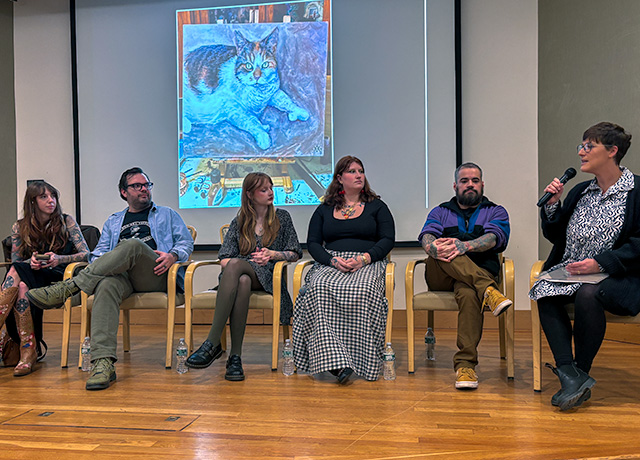
“As a tattoo artist, you’re essentially a small business owner,” said Doug Fortin ’06. “You have to constantly be on it.”
Fortin, along with Danielle Duncan ’14, Melissa Massicott ’23, MacKenzie Shaughnessy ’22, and Alex Vi ’08, shared their experiences of what it’s like to make a living as a tattoo artist. It’s a more common career path for HAS students than you might think.
“A lot of our students are not only tattoo enthusiasts, they come to art school in order to become tattoo artists,” says Carrie Cushman, former director and curator of the HAS galleries. But, Cushman says, many alumni told her they’ve seen a disconnect between tattooing and other forms of art. “They were kind of forced to keep their studio practice separate from their tattoo practice.”
Bridging that divide is the idea behind the exhibit Human Marks: Tattooing in Contemporary Art, which is at HAS’s Joseloff Gallery until December 13. Three years in the making, the exhibit brings together fifteen global contemporary artists to explore how tattooing shapes their art practices. It includes many examples of tattoo art itself, such as the “flash” designs that allow prospective clients to view an artist’s work before having it inked into their skin.
Danielle Duncan ’14, Hartford Art School AlumConnections with the professors and other students were a huge part of my success. It was really hard to be a woman getting into the industry. Just having these teacher connections, I’ve been able to have so many successes in different parts of the art industry.
But Human Marks also includes new tattoo-inspired works—in media as diverse as painting, video, sculpture, clothing, even perfumerie—that were commissioned for the exhibit as part of the 8th International Distinguished Artists Symposium and Exhibition (IDASE), which brings new and established artists and their works to the University of Hartford. In conjunction with the main exhibit at the Joseloff Gallery, Human Marks has also included live tattoo demonstrations and an installation and 8-hour performance at HAS’s Slipe Gallery called Realigned Possession.
Cushman returned as guest curator of Human Marks after recently passing the directorship of the HAS galleries to Adam Chau.
“I wanted our students to see themselves and their aspirations represented in the gallery by artists who are really making it in this field,” Cushman says. “I want the art world to better understand how tattooing is informing contemporary art. I think it’s important that a show like this happen at an art school, because of that connection to the students. This show grew in ways that I never expected, but it started with our students.”
For their part, the artists on the alumni panel credit the skills and connections they acquired at HAS with helping them establish themselves in a challenging and competitive field.
“Connections with the professors and other students were a huge part of my success,” Duncan says. “It was really hard to be a woman getting into the industry. Just having these teacher connections, I’ve been able to have so many successes in different parts of the art industry.”